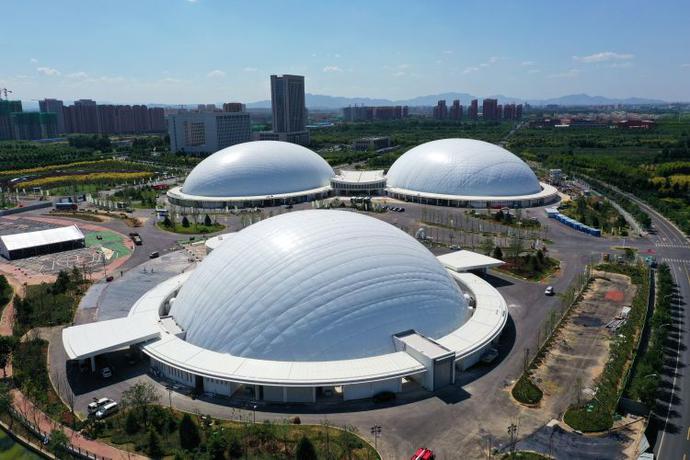In today's era of accelerating urbanization and people's increasing concern for a livable environment, air architecture, as a unique design concept, is leading the transformation of the construction industry. We have entered an era that pursues the coexistence of comfort and sustainability, and air architecture has undoubtedly become an outstanding representative of this concept. Its core concept aims to create a pleasant living environment while living in harmony with nature, providing humans with a healthier and more sustainable lifestyle.
Air architecture is not just a unique design in appearance, but also a comprehensive consideration of indoor air quality, energy efficiency and ecological sustainability. By introducing advanced technology and green building principles, air architecture breaks the boundaries of traditional architecture and organically connects humans and nature. This article will delve into the relationship between comfort and sustainability, and explore the habitability of air architecture in this field, thereby providing new possibilities for our future living environment. Let us step into this architectural field full of innovation and sustainable vitality, and appreciate the new living experience that air architecture brings us.
Background of Air Architecture: Exploring the Livability of Air Domes
In the ever-evolving landscape of architectural innovation, a remarkable concept has emerged to redefine our understanding of sustainable and comfortable living – Air Architecture, epitomized by the fascinating structures known as "Air Domes." As urbanization accelerates and environmental concerns take center stage, the quest for spaces that seamlessly blend comfort with sustainability has led to the rise of these extraordinary designs.
The Rise of Air Architecture:
Air Domes, a revolutionary subset of Air Architecture, represent a shift towards eco-conscious and breathable living spaces. These structures, characterized by their lightweight and flexible membrane enclosures, showcase a commitment to harmonizing human habitats with the natural environment. The concept draws inspiration from the fundamental principles of nature, aiming to create living spaces that not only coexist with the surrounding air but actively engage with it.
Key Features of Air Domes:
Flexibility and Adaptability: Air Domes are celebrated for their adaptability to diverse environments. The inflatable membrane allows for easy assembly and disassembly, making them suitable for temporary events or as semi-permanent structures.
Natural Ventilation: Unlike conventional buildings, Air Domes prioritize natural ventilation. The lightweight fabric enables the free flow of air, creating an environment that is not only energy-efficient but also conducive to a healthier indoor atmosphere.
Sustainability at the Core: Sustainability is a cornerstone of Air Architecture. Air Domes often incorporate eco-friendly materials and innovative construction techniques, minimizing their environmental footprint.
The Intersection of Comfort and Sustainability:
Air Architecture challenges the notion that sustainable living requires sacrificing comfort. Through designs like Air Domes, it seeks to strike a harmonious balance between human needs and ecological responsibility. These structures showcase how architecture can contribute to the well-being of both inhabitants and the planet.

Looking Ahead:
As we delve deeper into the exploration of Air Architecture, particularly the captivating world of Air Domes, it becomes evident that these designs are not just architectural marvels; they are a statement about our commitment to creating livable spaces that resonate with the principles of sustainability. In the subsequent sections, we will delve into the specific aspects that contribute to the livability of Air Domes, examining their impact on indoor air quality, energy efficiency, and overall well-being. Join us on this journey into the realm of Air Architecture, where innovation meets sustainability for a brighter future.
Factors Contributing to Livability in Permanent Inflatable Buildings
Livability in permanent inflatable buildings, such as Air Domes, is a multifaceted concept that encompasses various factors. These structures are designed not only for functionality but also to enhance the overall quality of living. Let's explore the key factors that contribute to the livability of permanent inflatable buildings:
Adaptive Design:
Natural Lighting and Transparency:
Energy Efficiency:
Indoor Air Quality:
Durability and Stability:
Aesthetic Appeal:
Customization and Personalization:
Insulation:
Sustainable Construction Materials:
Community Integration:
In the exploration of habitability, permanent inflatable buildings, especially air domes, present endless possibilities. The design of these buildings not only achieves breakthroughs in practicality, but also aims to improve the overall quality of life. Designed to adapt to different environments and uses, these buildings become extremely flexible, providing diverse possibilities for various application scenarios.
By introducing transparent materials to promote natural light, improve indoor air quality, and promote energy efficiency and long-lasting stability, permanent inflatable buildings embody a comprehensive consideration of the well-being of their occupants. They are not only outstanding representatives of architecture, but also a reflection of our commitment to creating a livable and sustainable lifestyle.
The aesthetic appeal and flexibility of these buildings make them not only functional carriers, but also comfortable and livable living spaces. With an emphasis on personalization and customization needs, permanent inflatable buildings provide residents with the opportunity to personalize their spaces and strengthen the close connection between residents and space.
By continuing to use the site you agree to our privacy policy Terms and Conditions.